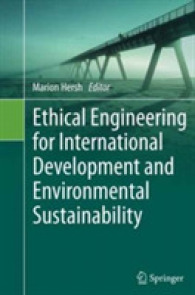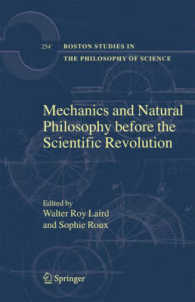- ホーム
- > 洋書
- > 英文書
- > Computer / General
Full Description
The need for a comprehensive survey-type exposition on formal languages and related mainstream areas of computer science has been evident for some years. In the early 1970s, when . the book Formal Languages by the second mentioned editor appeared, it was still quite feasible to write a comprehensive book with that title and include also topics of current research interest. This would not be possible anymore. A standard-sized book on formal languages would either have to stay on a fairly low level or else be specialized and restricted to some narrow sector of the field. The setup becomes drastically different in a collection of contributions, where the best authorities in the world join forces, each of them concentrat ing on their own areas of specialization. The present three-volume Handbook constitutes such a unique collection. In these three volumes we present the current state of the art in formal language theory. We were most satisfied with the enthusiastic response given to our request for contributions by specialists representing various subfields. The need for a Handbook of Formal Languages was in many answers expressed in different ways: as an easily accessible his torical reference, a general source of information, an overall course-aid, and a compact collection of material for self-study. We are convinced that the final result will satisfy such various needs. The theory of formal languages constitutes the stem or backbone of the field of science now generally known as theoretical computer science.
Contents
of Volume 3.- 1. Tree Languages.- 1. Introduction.- 2. Trees and terms.- 3. Algebraic preliminaries.- 4. Term rewriting systems.- 5. Finite tree recognizers.- 6. Regular tree grammars.- 7. Tree language operations and closure properties of Rec.- 8. Local tree languages.- 9. A Kleene theorem for tree languages.- 10. Regular tree systems.- 11. Algebraic characterizations of recognizability.- 12. Monadic second-order logic and regular tree languages.- 13. Families of special regular tree languages.- 14. The yield-function and context-free languages.- 15. Context-free tree grammars and pushdown tree recognizers.- 16. Tree transformations and tree transducers.- 17. Composition and decomposition of tree transformations.- 18. Tree transducers with regular look-ahead.- 19. Generalized syntax directed translations.- 20. Surface tree languages.- 21. The hierarchies of surface tree languages and transformational languages.- 22. Some further topics.- References.- 2. Tree-Adjoining Grammars.- 1. Introduction.- 2. Tree-adjoining grammars.- 3. Lexicalized grammars.- 4. 'Lexicalization' of CFGs.- 5. Closure of TAGs under lexicalization.- 6. Summary of lexicalization.- 7. Embedded push-down automaton (EPDA).- 8. Linguistic relevance.- 9. Some variants of TAGs.- 10. Parsing lexicalized tree-adjoining grammars (LTAG).- 11 Summary.- References.- 3. Context-Free Graph Grammars.- 1. Introduction.- 2. Node and edge replacement.- 3. Hyperedge replacement grammars.- 4. Node replacement grammars.- 5. Monadic second order logic.- 6. Graph grammars generating strings and trees.- 7. Tree grammars generating graphs.- References.- 4. Two-Dimensional Languages.- 1. Introduction.- 2. Preliminaries.- 3. Regular expressions.- 4. Automata.- 5. Grammars.- 6. Logic formulas.- 7. Tiling systems.- 8.Equivalence theorems.- 9. Properties of recognizable languages.- 10. Recognizable functions.- 11. Beyond finite state recognizability.- References.- 5. Basics of Term Rewriting.- 1. Introduction.- 2. Terms.- 3. Church—Rosser properties.- 4. Orderings.- 5. Completion.- 6. Rewriting modulo a relation.- 7. Sundries.- References and further reading.- 6. ?-Languages.- 1. Introduction.- 2. Topology for languages and ?-languages.- 3. The Chomsky hierarchy of ?-languages.- 4. Languages and ?-languages.- 5. Wagner's hierarchy.- References.- 7. Languages, Automata, and Logic.- 1. Introduction.- 2. Models and formulas.- 3. Automata and MSO-logic on finite words and trees.- 4. First-order definability.- 5. Automata and MSO-logic on infinite words.- 6. Automata and MSO-logic on infinite trees.- References.- 8. Partial Commutation and Traces.- 1. Introduction.- 2. Free partially commutative monoids.- 3. Combinatorial properties.- 4. Recognizable trace languages.- 5. Rational trace languages.- 6. Dependence graphs and logic.- 7. Asynchronous automata.- 8. Infinite traces.- References.- 9. Visual Models of Plant Development.- 1. Introduction.- 2. Developmental models of plant architecture.- 3. Formal description of branching structures.- 4. Fundamentals of modeling using L-systems.- 5. Random factors in development.- 6. Life, death, and reproduction.- 7. Development controlled by endogenous mechanisms.- 8. Development controlled by exogenous mechanisms.- 9. Conclusions.- 10. Acknowledgements.- References.- 10. Digital Images and Formal Languages.- 1. Introduction.- 2. Black and white images and finite automata.- 3. Grayscale images and WFA.- 4. Weighted finite transducers.- 5. Examples of WFT.- References.








